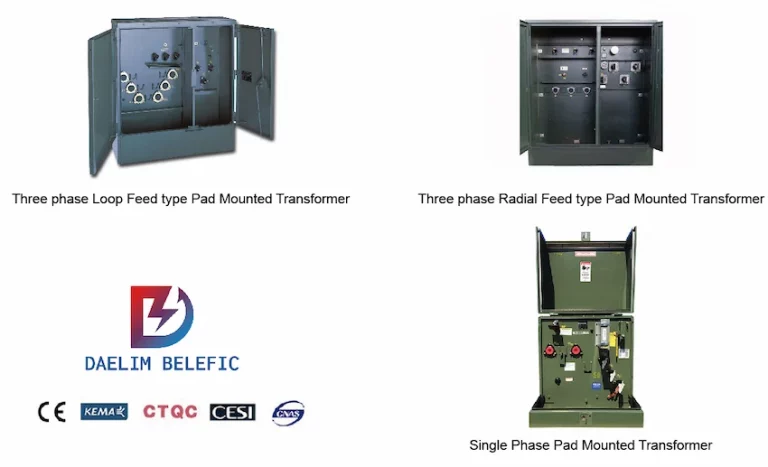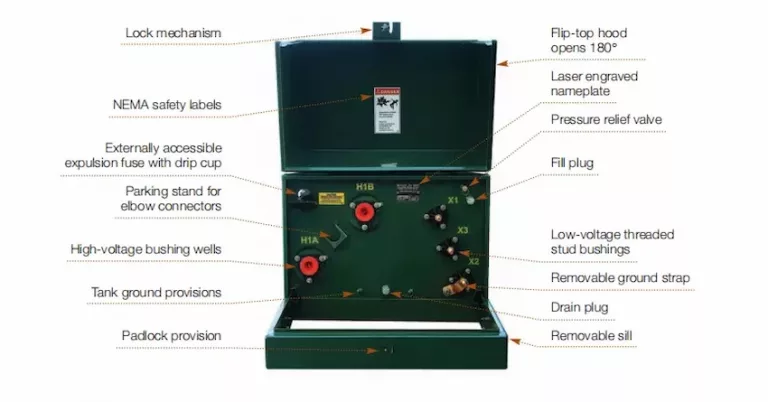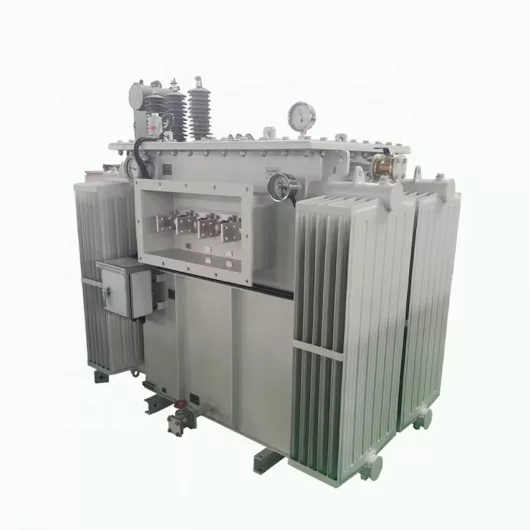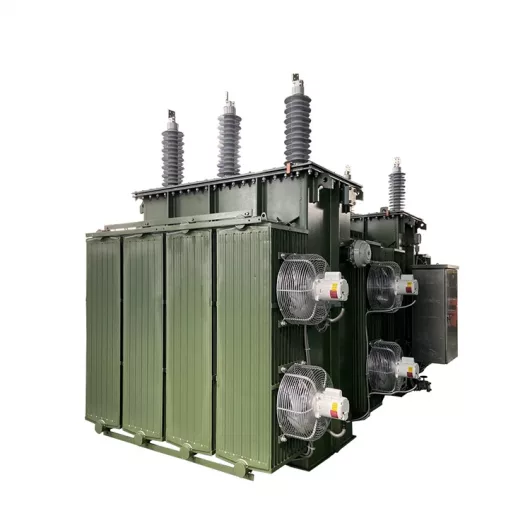ELECTRIC, WITH AN EDGE
The Padmounted Transformer is a transformer that is used in the installation of underground cable systems.
It is usually installed with a cable and can either step up or step down the voltage.
The mounting of the transformer is done by burying it into a trench and then backfilling it.
PadMounted Transformers are used to provide power to high voltage distribution lines.
They are used for short distances, typically under 1000 feet.
This is a much more efficient and cost-effective method of transferring electricity.
PadMounted Transformers use a series of pylons that can transmit power for much farther distances.
DAELIM delivers the most advanced transformer technology in the industry.
They developed a variety of transformer products, not just in Korea, but around the world.
They manufacture transformers for every need from small to large capacity, from low voltage to high voltage.
The pad-mounted transformer is a high-voltage power transformer mounted onto an area where the equipment is located.
This type of transformer is usually found in substations and distribution centers.
The pad-mounted transformer usually supplies power to the electrical equipment located in the center of the floor space.
These transformers are usually used to reduce the voltage of three-phase power.
Then, it distributes power to equipment on a pad or in a cabinet at the load center.
They are designed to accommodate the customer’s needs by providing three voltage levels for three different types of loads.
PadMounted Transformers are used to convert alternating current for use in low-voltage DC circuits.
They are similar in size to a power supply, with up to 400 VDC voltage output.
The pad-mounted transformer is typically located on an outside wall of the building.
However, it is sometimes placed inside the building.

Inside a pad-mounted transformer, you can find a stator and a rotor.
The stator comprises a laminated steel core with slots for the magnetic steel sheets to be inserted.
The rotor comprises two magnetized steel sheets that are wound with copper wire to form coils.
A pad-mounted transformer is used on a circuit with a solid conductor on which an alternating current is induced.
It contains a core and a primary winding. The core is a ferromagnetic material, typically iron.
The primary winding is wound around the core and can be either single or polyphase.
A secondary winding may also be employed to provide multiple voltage sources.
Additionally, a pad-mounted transformer is installed on the ground.
The primary and secondary windings are then wound on a laminated core cut from a solid bar of steel.
The primary and secondary windings are encapsulated with insulation material and then encased by a weatherproof protective case.
Lastly, PadMounted Transformers are configured with primary and secondary windings.
The transformer primary winding is connected to an input voltage, and the secondary winding is connected to the load.
You can configure it with single-phase or three-phase windings.
This configuration reduces the number of connections needed in the transformer and allows for improved efficiency.
Single-phase transformers are most often used in residential and commercial settings, while three-phase is more common in industrial settings.
Single-Phase Pad Mounted Transformers are power transformers in which the primary and secondary coils are mounted to a common base or core.
The use of transformers in electric power systems is to convert electrical energy from one voltage level to another.
This is to match the customer’s requirements.
Single-phase transformers are designed for use on 120V circuits, except for 240V circuits.
However, the three-phase transformer is designed for 208V or 240V circuits.
A single-phase pad-mounted transformer connection uses coils of wire wrapped around an insulated core to produce electrical power with single-phase AC voltage.
This type of transformer converts three-phase AC voltage to single-phase AC voltage in residential, commercial, and industrial buildings.
The power transfer process starts with the transformer converting the input voltage into a high voltage (HV) and low voltage (LV).
Then, it distributes power to the Primary and Secondary circuits.
The high voltage is stepped down to a low voltage for use by downstream equipment.
The low voltage is stepped up to a higher voltage for use by upstream equipment.

A three-phase pad-mounted transformer is a three-phase electrical power distribution transformer used for supplying power to an electric motor.
They are available in various amperes and voltage ratings and serve as the most popular type of transformer.
A three-phase transformer is typically mounted on a pad which distributes power to the three phases.
They are usually used in applications that require high power and high frequency.
Usually, s three-phase pad-mounted transformer is a pad-mounted transformer installed on the outside of a building.
It can be made up of one or more coils with an iron core.
These are connected with the three phases of the building’s electrical service. The transformer steps down the voltage from 240V to 120V.
Three-phase PadMounted Transformers are typically found in distribution systems.
They are typically considered to be bulky and difficult to install.
The only way to connect the three phases is through one common point. It requires additional work to shift the phase correctly.
It is converted among the three standard phases of power usage, with each phase serving an area. They are most commonly used in the distribution of power from the electrical service panel through the home.
PadMounted Transformers are used in circuits where the voltage is higher than the current needed.
This reduces the size and weight of the transformer, as well as its cost.
PadMounted Transformers are applied in fluorescent lighting, battery chargers, LED lights, and electric motor control circuits.
Additionally, the PadMounted Transformers reduce the voltage of high-voltage alternating current (AC) power.
The transformer is typically located near the electricity distribution substation or sub-transmission substation.
They are also used to reduce the voltage of high voltage direct current (HVDC) power.
Remember that a pad-mounted transformer is a power transformer that has been installed on a mounting pad.
This mounting pad is usually a concrete slab or a steel sheet.
A pad-mounted transformer is typically used to power the electric equipment on an electric utility pole.
Also, PadMounted Transformers are power transformers mounted on a suitable insulating pad or stand.
The transformer is usually connected to the load via a three-phase busbar, and the busbar must be suitably insulated from the pad.
They are used for service applications where the primary distribution system is on the ground. These include underground tunnels and mines.
Installing a pad-mounted transformer can be difficult, especially if there isn’t enough space for the transformer on the ground.
Many considerations need to be made before deciding how to mount a transformer.
You need to determine which type of pad you will be using and how it will be attached.
The transformer needs to be located above the floodplain and floodway, and it should not interfere with any drainage structures.
Usually, installation is done outdoors on a concrete pad.
The transformer is mounted on an insulated base of insulating material.
The transformer must be installed at least 10 feet away from any building, even if the building is not occupied.
The transformer must be at least five feet away from any pool, spa, or other body of water.
Cooper Pad-mounted Transformer | Pad-mounted Transformers | Daelim
PadMounted Transformers can be located as close as a few feet from a house, but the closer the transformer is to your house, the worse it will affect your electric system.
If you’re within 50 feet of a pad-mounted transformer, you might need to do some electrical work before you submit your application for approval.
Yes. It is safe to sit next to a pad-mounted transformer. PadMounted Transformers are designed with safety in mind.
They are also mounted safely to minimize the risk of accidental contact by people or animals.
It is not unusual for electrical equipment to be painted green for safety reasons.
When people are working on these types of electrical equipment, they are shocked by the live voltage inside the unit.
The green paint serves as a warning to the user that there is live voltage inside.
Understanding Live Front Three Phase Pad-Mounted Transformer
A pad-mounted transformer provides a reliable and cost-efficient way to maintain the flow of electricity.
The transformer is installed on a pad and situated where there is easy access to utility power.
PadMounted Transformers are an inexpensive solution for industrial plants to replace or supplement their electric power.
DAELIM is a global transformer manufacturer with its headquarters in Korea.
With the most advanced transformer technology in the industry, Daelim stays true to its goal of delivering quality products and services.
The company manufactures the PadMounted Transformers with high quality standard materials.
When you need to find more than just existing transformers, Daelim’s Transformer Service Center can help you design and produce distribution transformers that meet your unique needs.
We have our own factory and a professional team of engineers, which can design and modify application requirements that meet all your conditions.
Download Resource
ELECTRIC, WITH AN ENGE-- DAELIM BELEFIC



